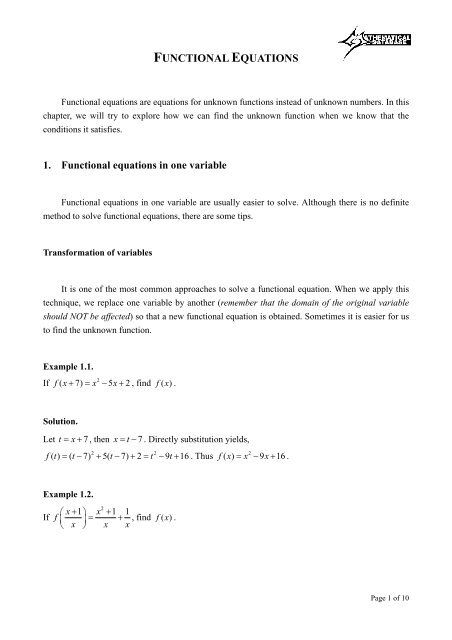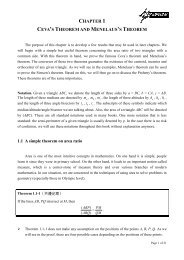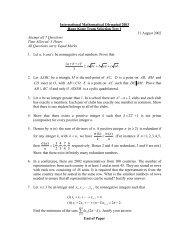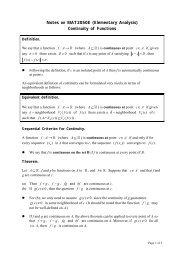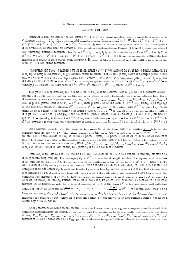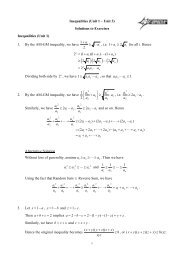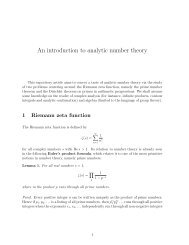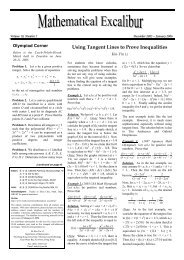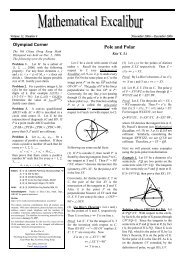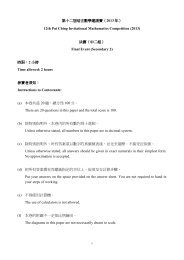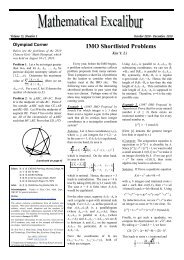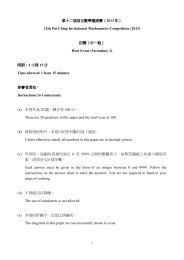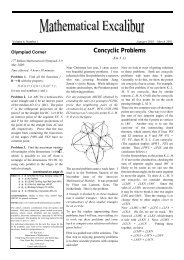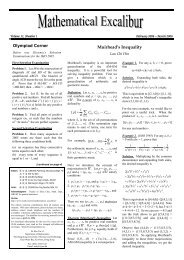1. Functional equations in one variable
1. Functional equations in one variable
1. Functional equations in one variable
You also want an ePaper? Increase the reach of your titles
YUMPU automatically turns print PDFs into web optimized ePapers that Google loves.
Mathematical Database<br />
FUNCTIONAL EQUATIONS<br />
<strong>Functional</strong> <strong>equations</strong> are <strong>equations</strong> for unknown functions <strong>in</strong>stead of unknown numbers. In this<br />
chapter, we will try to explore how we can f<strong>in</strong>d the unknown function when we know that the<br />
conditions it satisfies.<br />
<strong>1.</strong> <strong>Functional</strong> <strong>equations</strong> <strong>in</strong> <strong>one</strong> <strong>variable</strong><br />
<strong>Functional</strong> <strong>equations</strong> <strong>in</strong> <strong>one</strong> <strong>variable</strong> are usually easier to solve. Although there is no def<strong>in</strong>ite<br />
method to solve functional <strong>equations</strong>, there are some tips.<br />
Transformation of <strong>variable</strong>s<br />
It is <strong>one</strong> of the most common approaches to solve a functional equation. When we apply this<br />
technique, we replace <strong>one</strong> <strong>variable</strong> by another (remember that the doma<strong>in</strong> of the orig<strong>in</strong>al <strong>variable</strong><br />
should NOT be affected) so that a new functional equation is obta<strong>in</strong>ed. Sometimes it is easier for us<br />
to f<strong>in</strong>d the unknown function.<br />
Example <strong>1.</strong><strong>1.</strong><br />
2<br />
If f( x+ 7) = x − 5x+ 2, f<strong>in</strong>d f ( x ).<br />
Solution.<br />
Let t = x+ 7 , then x = t − 7 . Directly substitution yields,<br />
2 2<br />
2<br />
f( t) = ( t− 7) + 5( t− 7) + 2= t − 9t+ 16. Thus f( x) = x − 9x+ 16.<br />
Example <strong>1.</strong>2.<br />
If<br />
2<br />
⎛ x+ 1⎞ x + 1 1<br />
f ⎜ ⎟ = +<br />
⎝ x ⎠ x x<br />
, f<strong>in</strong>d f ( x ).<br />
Page 1 of 10
Solution.<br />
x + 1<br />
Let t = , then<br />
x<br />
1<br />
x = t − 1<br />
. Directly substitution yields,<br />
()<br />
f t<br />
2<br />
⎛ 1 ⎞<br />
⎜ ⎟ + 1<br />
⎝t<br />
−1⎠<br />
1<br />
⎛ 1 ⎞ 1<br />
⎜ ⎟<br />
⎝t<br />
−1⎠<br />
t −1<br />
2<br />
= + = −<br />
2<br />
t<br />
t+ <strong>1.</strong><br />
Mathematical Database<br />
Thus<br />
2<br />
f ( x) = x − x+ <strong>1.</strong><br />
Example <strong>1.</strong>3.<br />
2<br />
If f (ln x) = x + x+ 1, where x > 0 , f<strong>in</strong>d f ( x ).<br />
Solution.<br />
Let<br />
t = ln<br />
x, then<br />
x<br />
t<br />
= e . Directly substitution yields,<br />
t<br />
( ) 2<br />
t<br />
2x<br />
x<br />
f() t = e + e + <strong>1.</strong> Thus f( x) = e + e + <strong>1.</strong><br />
In general, if we have f ( g( x)) = h( x)<br />
and g( x)<br />
has an <strong>in</strong>verse function, then we may replace<br />
g<br />
1 ( x)<br />
and get<br />
f ( x) = h( g ( x))<br />
.<br />
− −1<br />
x by<br />
Solv<strong>in</strong>g equation<br />
Sometimes after perform<strong>in</strong>g transformation of <strong>variable</strong>s, we can arrive at simultaneous<br />
<strong>equations</strong>. We can f<strong>in</strong>d the unknown function after solv<strong>in</strong>g the simultaneous <strong>equations</strong>. We may also<br />
treat the unknown function as a <strong>variable</strong> <strong>in</strong> ord<strong>in</strong>ary <strong>equations</strong> and solve it.<br />
Example <strong>1.</strong>4.<br />
If<br />
f ( x) 4+<br />
x<br />
=<br />
2<br />
3 + f ( x)<br />
x<br />
2<br />
, f<strong>in</strong>d f ( x ).<br />
Solution.<br />
It is equivalent to<br />
2 2<br />
x f x x f x<br />
( ) = (4 + )(3 + ( )) . Simplify<strong>in</strong>g it, we have<br />
Page 2 of 10
2 2 2<br />
x f x = + x + + x f x<br />
( ) 3(4 ) (4 ) ( )<br />
− = +<br />
2<br />
4 f( x) 3(4 x )<br />
f( x)<br />
=−<br />
2<br />
3(4 + x )<br />
4<br />
Mathematical Database<br />
Example <strong>1.</strong>5.<br />
If<br />
⎛ x −1⎞<br />
f ( x) + f ⎜ ⎟=<br />
1+ x, f<strong>in</strong>d f ( x ).<br />
⎝ x ⎠<br />
Solution.<br />
Let<br />
x −1<br />
t = , then<br />
x<br />
1<br />
x = 1 − t<br />
. Direct substitution yields<br />
f<br />
⎛ 1 ⎞ 1<br />
⎜ ⎟ + f() t = 1 +<br />
⎝1−<br />
t⎠<br />
1−<br />
t<br />
(<strong>1.</strong>1)<br />
⎛ 1 ⎞ 1<br />
f ⎜ ⎟ + f( x) = 1 +<br />
⎝1−<br />
x ⎠<br />
1−<br />
x<br />
Let<br />
1<br />
t = 1 − x<br />
, then<br />
t −1<br />
x = . Direct substitution yields<br />
t<br />
(<strong>1.</strong>2)<br />
⎛t−1⎞ ⎛ 1 ⎞ t−1<br />
f ⎜ ⎟+ f ⎜ ⎟= 1+<br />
⎝ t ⎠ ⎝1−<br />
t⎠<br />
t<br />
⎛ x −1⎞ ⎛ 1 ⎞ x −1<br />
f ⎜ ⎟+ f ⎜ ⎟= 1+<br />
⎝ x ⎠ ⎝1−<br />
x⎠<br />
x<br />
On the other hand, by substitut<strong>in</strong>g it <strong>in</strong>to (1), we have<br />
⎛ x −1⎞<br />
(<strong>1.</strong>3)<br />
f ( x) + f ⎜ ⎟= 1+x<br />
⎝ x ⎠<br />
((<strong>1.</strong>1) + (<strong>1.</strong>2) + (<strong>1.</strong>3))/2 :<br />
⎛ x−1⎞ ⎛ 1 ⎞ 1⎛<br />
1 x−1<br />
⎞<br />
(<strong>1.</strong>4)<br />
f ( x) + f ⎜ ⎟+ f ⎜ ⎟= ⎜3+ + + x ⎟⎠<br />
⎝ x ⎠ ⎝1−x⎠ 2⎝<br />
1−x x<br />
By subtract<strong>in</strong>g (<strong>1.</strong>2) from (<strong>1.</strong>4), we have<br />
3 2<br />
1⎛ 1 x−1 ⎞ ⎛ x−1⎞ 1⎛ 1 x−1⎞<br />
− x + x + 1<br />
f( x) = ⎜3+ + + x⎟− ⎜1+ ⎟= ⎜1+ + x− ⎟=<br />
2⎝ 1−x x ⎠ ⎝ x ⎠ 2⎝ 1−x x ⎠ 2 x(1 −x)<br />
Page 3 of 10
Method of undeterm<strong>in</strong>ed coefficients<br />
Mathematical Database<br />
When we know that the unknown function satisfies certa<strong>in</strong> conditions, say it is a quadratic or<br />
2<br />
cubic function, we can immediately set up <strong>variable</strong>s (e.g. let f ( x)<br />
= ax + bx+ c if f ( x ) is a<br />
quadratic polynomial) and solve for them.<br />
Example <strong>1.</strong>6.<br />
If f ( x)<br />
is a quadratic function such that f ( x+ 1) − f( x) = 8x+ 3 and f (0) = 5 , f<strong>in</strong>d f ( x ).<br />
Solution.<br />
Let<br />
2<br />
f ( x)<br />
ax bx c<br />
Simplify<strong>in</strong>g gives<br />
= + + , then ax ( + 1) 2 + bx ( + 1) + c−ax 2 −bx− c= 8x+3.<br />
After solv<strong>in</strong>g, we have a = 4 and b =−<strong>1.</strong><br />
Putt<strong>in</strong>g<br />
x = 0, we have c = 5 .<br />
2ax + a + b = 8x<br />
+ 3.<br />
Therefore<br />
2<br />
f ( x) = 4x − x+ 5.<br />
2. <strong>Functional</strong> <strong>equations</strong> <strong>in</strong> more than <strong>one</strong> <strong>variable</strong><br />
For functional <strong>equations</strong> with more than <strong>one</strong> <strong>variable</strong>, we can also apply the methods<br />
menti<strong>one</strong>d above. Besides we can also try to substitute some special values, say x = y = 0 <strong>in</strong>to the<br />
given condition given to obta<strong>in</strong> some results. As it is very difficult to describe these techniques <strong>in</strong><br />
words, we will try to see their application <strong>in</strong> various examples below.<br />
Example 2.<strong>1.</strong><br />
If f : →<br />
satisfies<br />
<strong>1.</strong> f (1) = 2 ,<br />
2. For all xy∈ , , f( xy) = f( x) f( y) − f( x+ y) + 1, f<strong>in</strong>d f ( x ).<br />
Page 4 of 10
Solution.<br />
Putt<strong>in</strong>g<br />
y = 1, then<br />
Mathematical Database<br />
f( x) = f( x) f(1) − f( x+ 1) + 1<br />
= 2 f( x) − f( x+ 1) + 1<br />
f( x+ 1) = f( x) + 1<br />
Therefore apply<strong>in</strong>g condition 1 and by mathematical <strong>in</strong>duction, for all <strong>in</strong>teger x, we have<br />
f ( x) = x+ <strong>1.</strong><br />
m<br />
m<br />
For any rational number, let x = where m, n are <strong>in</strong>tegers and n is not zero. Putt<strong>in</strong>g x = , y = n,<br />
n<br />
n<br />
⎛<br />
then ( ) m ⎞ ⎛m<br />
⎞<br />
f m = f ⎜ ⎟( n+ 1) − f ⎜ + n⎟<br />
1<br />
⎝ n ⎠ ⎝ n ⎠ + .<br />
S<strong>in</strong>ce f( x+ 1) = f( x)<br />
+ 1 for ∀x<br />
∈ , we have<br />
⎛m<br />
⎞ ⎛m⎞<br />
f ⎜ + n⎟= f ⎜ ⎟+n.<br />
⎝ n ⎠ ⎝ n ⎠<br />
⎛m⎞ ⎛m⎞<br />
Substitut<strong>in</strong>g this <strong>in</strong>to the orig<strong>in</strong>al equation, we have m+ 1 = f ⎜ ⎟( n+ 1) − f ⎜ ⎟−n+ <strong>1.</strong> Thus<br />
⎝ n ⎠ ⎝ n ⎠<br />
⎛m⎞ m<br />
f ⎜ ⎟ = + <strong>1.</strong><br />
⎝ n ⎠ n<br />
So we have f ( x) = x+ 1 ∀x<br />
∈ .<br />
Remark.<br />
In this question we can see that we first solve the functional equation for a special case (we found<br />
f ( x ) when x ∈ ), then we solve for the more general case. (we found f ( x ) when x ∈ ). Indeed,<br />
this method is used <strong>in</strong> many occasions. For<br />
f<strong>in</strong>d<br />
when<br />
f ( x ) when<br />
x∈<br />
about this later.<br />
x ∈ . Then, f<strong>in</strong>d f ( x ) when x ∈ by substitut<strong>in</strong>g<br />
f : →<br />
, we can apply this method similarly. First,<br />
m<br />
x = . F<strong>in</strong>ally, f<strong>in</strong>d f ( x )<br />
n<br />
by the density of rational numbers (for cont<strong>in</strong>uous functions only). We shall see more<br />
Example 2.2.<br />
If<br />
2 2<br />
( x y) f( x y) ( x y) f( x y) 4 xy( x y )<br />
− + − + − = − for all x,<br />
y , f<strong>in</strong>d f ( x ).<br />
Solution.<br />
The given condition is equivalent to<br />
Page 5 of 10
f( x+ y) f( x−<br />
y)<br />
− = 4 xy = ( x+ y) −(<br />
x−<br />
y)<br />
x+ y x−<br />
y<br />
2 2<br />
Mathematical Database<br />
f( x+ y) 2 f( x−<br />
y)<br />
2<br />
− ( x + y) = −(<br />
x−<br />
y ) for all x,<br />
y .<br />
x+ y x−<br />
y<br />
Thus<br />
f( x)<br />
x<br />
2<br />
− x is a constant. Let<br />
f( x)<br />
x<br />
2<br />
− x = k , then<br />
3<br />
f ( x)<br />
x kx<br />
= + .<br />
Remark.<br />
In this question, we have a symmetric condition. By us<strong>in</strong>g the symmetry, we reduce the equation to<br />
a <strong>one</strong>-<strong>variable</strong> functional equation. This is a useful technique for symmetric functional <strong>equations</strong>.<br />
Example 2.3.<br />
If f<br />
: → satisfies<br />
2<br />
f ( x + f( y)) = y+ xf( x)<br />
for all xy∈ , , f<strong>in</strong>d f ( x ).<br />
Solution.<br />
Putt<strong>in</strong>g<br />
x = 0 , then f ( f( y))<br />
= y. Thus we have,<br />
(2.1)<br />
f y xf x f f x f y x f y<br />
2 2<br />
( + ( )) = ( ( + ( ))) = + ( )<br />
Now replace x by f ( x ),<br />
2<br />
f ( y+ ( f( x) f( f( x))) = ( f( x)) + f( y)<br />
. Remember that f ( f( y))<br />
= y, so<br />
(2.2)<br />
f y xf x f x f y<br />
2<br />
( + ( )) = ( ( )) + ( )<br />
Compar<strong>in</strong>g (2.1) and (2.2), we have<br />
(2.3) ( ) 2 2<br />
f ( x)<br />
= x<br />
Now replace<br />
y by f ( y ) <strong>in</strong> the orig<strong>in</strong>al equation, we have<br />
2<br />
f ( x + y) = f( y) + xf( x)<br />
. Squar<strong>in</strong>g both sides, we have<br />
( ) 2<br />
2 2 2 2 2 2 4 2<br />
( x + y) = f( x + y) = f( y) + x f( x) + 2 xf( x) f( y) = x + y + 2 xf( x) f( y)<br />
From this, we have<br />
(2.4) xy = f( x) f( y)<br />
From (2.3), we have f ( x ) = x or f ( x)<br />
=− x.<br />
If f ( x ) = x, from (2.4) we have f ( x ) = x for x∈R .<br />
Page 6 of 10
If f ( x ) =−x, from (2.4) we have f ( x)<br />
= − x for x∈R .<br />
Mathematical Database<br />
Therefore f ( x ) = x or f ( x)<br />
=− x.<br />
Remark.<br />
In this question, we replace (or substitute) <strong>variable</strong>s by other th<strong>in</strong>gs. (we replaced x by f ( x ) <strong>in</strong> the<br />
question). This is a very useful technique. Some common replacements and substitutions <strong>in</strong>clude:<br />
replac<strong>in</strong>g x by f ( x ); replac<strong>in</strong>g x by f ( f( x )); substitut<strong>in</strong>g x = 0; substitut<strong>in</strong>g x = y = 0; substitut<strong>in</strong>g<br />
x = 1, etc.<br />
Example 2.4.<br />
If f : →<br />
<br />
+<br />
satisfies<br />
<strong>1.</strong> f ( xf ( y)) = yf ( x)<br />
for all xy , ∈<br />
2. f( x) → 0 as x →∞, f<strong>in</strong>d f ( x ).<br />
+<br />
Solution.<br />
First, let us show that f ( x ) is surjective.<br />
Let<br />
x ⎛ ⎛ x ⎞ ⎞ x<br />
y = , then f ⎜xf ⎜ ⎟⎟<br />
= f ( x)<br />
= x . Therefore f ( x ) is surjective, i.e. for all y<br />
f ( x)<br />
⎝ ⎝ f( x) ⎠⎠<br />
f( x)<br />
there exists an x such that f ( x)<br />
Assume<br />
= y.<br />
f( y ) = <strong>1.</strong> Putt<strong>in</strong>g x = 1, then<br />
f (1) = f(1 f( y)) = yf(1)<br />
. So y = 1 and f (1) = <strong>1.</strong><br />
Now putt<strong>in</strong>g x = y , then f ( xf ( x)) = xf ( x)<br />
. Thus xf( x ) is a fixed po<strong>in</strong>t for the function. Let us<br />
show two th<strong>in</strong>gs about fixed po<strong>in</strong>t now.<br />
(i) If a, b are fixed po<strong>in</strong>ts of f, then f ( ab) = f ( af ( b)) = bf ( a)<br />
= ab . Thus ab is also a fixed<br />
(ii)<br />
po<strong>in</strong>t.<br />
⎛ 1⎞ ⎛1<br />
⎞ ⎛1⎞<br />
If a is a fixed po<strong>in</strong>t of f, then 1 = f(1) = f ⎜ai<br />
⎟= f ⎜ f( a)<br />
⎟=<br />
af ⎜ ⎟<br />
⎝ a⎠ ⎝a<br />
⎠ ⎝a⎠ . Thus ⎛1⎞ 1<br />
f ⎜ ⎟ =<br />
⎝a⎠<br />
a<br />
,<br />
which means 1 a<br />
is also a fixed po<strong>in</strong>t.<br />
Now, if xf ( x ) > 1 , then (( ( )) n<br />
n<br />
f xf x ) = ( xf ( x))<br />
. As n ,<br />
n<br />
n<br />
f (( xf ( x)) ) = ( xf ( x))<br />
. This contradicts with condition 2.<br />
→∞ [ ]<br />
xf ( x) n<br />
→∞ while<br />
Page 7 of 10
If<br />
xf ( x ) < 1, then by (ii) we have<br />
condition 2.<br />
Thus, we must have<br />
Remark.<br />
1<br />
xf( x)<br />
xf ( x ) = <strong>1.</strong> This means<br />
Mathematical Database<br />
is a fixed po<strong>in</strong>t larger than <strong>1.</strong> This aga<strong>in</strong> contradicts with<br />
f( x)<br />
1<br />
= .<br />
x<br />
The concept of fixed po<strong>in</strong>t is <strong>in</strong>troduced <strong>in</strong> this question. If f ( x)<br />
of f. It is not so commonly used but it is also a useful technique.<br />
= x, then x is called a fixed po<strong>in</strong>t<br />
3. Some famous functional <strong>equations</strong><br />
In this part, we will <strong>in</strong>troduce some famous functional <strong>equations</strong>. We may quote them directly<br />
<strong>in</strong> competitions.<br />
Theorem 3.<strong>1.</strong> (Cauchy equation)<br />
If f is a cont<strong>in</strong>uous function such that f ( x+ y) = f( x) + f( y)<br />
for all xy∈ , , then f ( x)<br />
= cx<br />
where c is a constant.<br />
Proof.<br />
We may use the technique menti<strong>one</strong>d <strong>in</strong> example 2.<strong>1.</strong><br />
First, put<br />
f ( x)<br />
y = 1 and let x be a positive <strong>in</strong>teger. Then f ( x+ 1) = f ( x)<br />
+ c, where c = f(1)<br />
. Thus<br />
= cx for positive <strong>in</strong>tegers x. It is easy to verify that (0) 0<br />
orig<strong>in</strong>al equation. For negative <strong>in</strong>tegers, we replace x by –x and get<br />
f = by putt<strong>in</strong>g x = y = 0 <strong>in</strong>to the<br />
f ( − x+ 1) = f( − x)<br />
+ c. Thus<br />
f ( − x)<br />
=−cx for positive <strong>in</strong>tegers x. Therefore we conclude that f ( x)<br />
= cx for <strong>in</strong>tegers x.<br />
Let<br />
m<br />
x = , where m, n are <strong>in</strong>tegers. Then we have<br />
n<br />
⎛m+<br />
1⎞ ⎛m⎞ ⎛1⎞<br />
f ⎜ ⎟= f ⎜ ⎟+<br />
f ⎜ ⎟<br />
⎝ n ⎠ ⎝ n ⎠ ⎝n⎠ , thus ⎛m<br />
⎞ ⎛1<br />
⎞<br />
f ⎜ ⎟=<br />
mf ⎜ ⎟<br />
⎝ n ⎠ ⎝n⎠ . However, 1 ⎛1⎞<br />
c = f ( ⋅ n ) = nf ⎜ ⎟<br />
n ⎝n⎠<br />
⎛1 ⎞ c<br />
f ⎜ ⎟ =<br />
⎝n⎠<br />
n<br />
and we have<br />
⎛1 ⎞ c<br />
f ⎜ ⎟ =<br />
⎝n⎠<br />
n<br />
. This implies f ( x)<br />
= cx for rational numbers x.<br />
. So<br />
Page 8 of 10
Mathematical Database<br />
Now, as f is cont<strong>in</strong>uous, we can always bound an irrational number by two rational numbers. (For<br />
example, we may bound π by 3, 3.1, 3.14, 3.141 and 4, 3.2, 3.15, 3.142 respectively). Let<br />
{ xn},<br />
xn∈ be such a sequence with lim x n<br />
= x , then by cont<strong>in</strong>uity of f, we have<br />
n→∞<br />
f ( x) = f(lim x ) = lim f( x ) = lim cx = cx. Therefore f ( x)<br />
n n n<br />
n→∞ n→∞ n→∞<br />
= cx for all x∈R .<br />
Q.E.D.<br />
Corollary 3.2.<br />
If f is a cont<strong>in</strong>uous function and for all xy∈ , ,<br />
(i) f ( x+ y) = f( x) f( y)<br />
then f ( x)<br />
= c<br />
(ii) f ( xy) = f ( x) + f ( y)<br />
then f ( x) = clnx<br />
(iii) f ( xy) = f ( x) f ( y)<br />
then f ( x)<br />
= x<br />
where c is a constant.<br />
x<br />
c<br />
Example 3.3.<br />
If<br />
f :(1, +∞)<br />
→ is a cont<strong>in</strong>uous function such that f ( xy) = xf ( y) + yf ( x)<br />
for all1 < xy , ∈ , f<strong>in</strong>d<br />
f ( x ).<br />
Solution.<br />
It is equivalent to f ( xy) = f ( x) + f ( y)<br />
. If we let<br />
xy x y<br />
gxy ( ) = gx ( ) + gy ( )<br />
f ( x)<br />
gx ( ) = , then the equation becomes<br />
x<br />
which is simply (ii) of corollary <strong>1.</strong>32 (although there is a m<strong>in</strong>or difference<br />
between them). So we have g( x) = clnxand<br />
f ( x) = xg( x) = cxlnx.<br />
Page 9 of 10
4. Exercises<br />
<strong>1.</strong> Solve the functional equation<br />
2<br />
f ( x+ 2) = x + 4x+ 6.<br />
Mathematical Database<br />
2. If<br />
⎛1<br />
⎞<br />
3 f ( x) + 2f<br />
⎜ ⎟=<br />
4x, f<strong>in</strong>d f ( x ).<br />
⎝ x ⎠<br />
3. If af ( x − 1) + bf (1 − x)<br />
= cx where a, b, c are constants, f<strong>in</strong>d f ( x ).<br />
4. Solve the functional equation xf ( x) + 2 xf ( − x) =− <strong>1.</strong><br />
5. F<strong>in</strong>d all cont<strong>in</strong>uous functions f for x > 0 such that<br />
f( x+ y)<br />
=<br />
f ( x) f( y)<br />
.<br />
f ( x) + f( y)<br />
6. F<strong>in</strong>d all cont<strong>in</strong>uous functions f such that f ( x+ y) = f( x) + f( y) + f( x) f( y)<br />
.<br />
7. If f ( x+ y) + f( x− y) = 2 f( x)cosy, f<strong>in</strong>d f ( x ).<br />
Harder problems<br />
8. (IMO 1982) The function f ( n ) is def<strong>in</strong>ed for all positive <strong>in</strong>tegers n and takes on non-negative<br />
<strong>in</strong>tegral values.<br />
Also, for all m, n<br />
Determ<strong>in</strong>e f (1982) .<br />
f ( m+ n) − f( m) − f( n) = 0 or 1<br />
f (2) = 0, f (3) > 0, and f (9999) = 3333.<br />
9. F<strong>in</strong>d all pairs of functions f, g:<br />
→<br />
such that<br />
(a) if x < y , then f ( x) < f ( y)<br />
(b) for all xy∈ , , g( y) f( x) + f( y) = f( xy)<br />
.<br />
10. F<strong>in</strong>d all f : Z→<br />
Z such that<br />
(a) f (1) = 1<br />
(b) for all mn∈Z , , f ( m+ n)( f( m) − f( n)) = f( m− n)( f( m) + f( n))<br />
.<br />
References:<br />
<strong>1.</strong> Notes on functional <strong>equations</strong>, by Mr. Kwok Ka Keung<br />
2. 華 羅 庚 學 校 數 學 課 本 ( 高 一 年 級 ), 出 版 社 : 中 國 大 百 科 全 書 出 版 社<br />
Page 10 of 10


